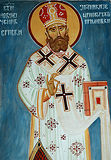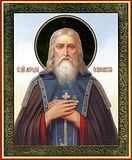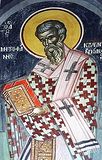

| Previous day | Next day |
| Old Style
June 4
|
Monday |
New Style
June 17
|
| 7th Week after Pascha. Tone 6. | No fast.
|
Afterfeast of the Ascension. ![]() St. Metrophanes, first archbishop of Constantinople (ca. 326).
St. Metrophanes, first archbishop of Constantinople (ca. 326). ![]() St. Methodius, founder of Peshnosha Monastery (Moscow), disciple of St. Sergius of Radonezh (1392).
St. Methodius, founder of Peshnosha Monastery (Moscow), disciple of St. Sergius of Radonezh (1392).
Martyrs Frontasius, Severinus, Severian, and Silanus, of Gaul (1st c.). Martyr Concordius of Spoleto, Italy (ca. 175). Hieromartyr Astius, bishop of Dyrrachium in Macedonia (110). St. Zosimas of Cilicia, bishop of Babylon in Egypt (6th c.). New Hieromartyr Ioannicius, metropolitan of Montenegro and the Littoral (1945). Sts. Eleazar and Nazarius, wonderworkers, of Olonets (15th c.).
Sts. Mary and Martha, sisters of St. Lazarus (1st c.). St. Titus, bishop of Byzantium (3rd c.). Hieromartyr Apotacius and Martyrs Zoticus, Atallus, Camasius, Philip, and 31 others, including Eutychius, Quirinus, Julia, Saturninus, Ninita, Fortunio, Gaddanus, and Amasus, beheaded at Noviodunum (Niculitel) (320). St. Optatus, bishop of Milevum in Numidia (376). St. Alonius of Scetis in Egypt (5th c.). St. Petroc, abbot, in Cornwall (594). Monk-martyr John, abbot, of Monagria Monastery, near Cyzicus (761). St. Sophia of Thrace (10th c.-11th c.).
Repose of Hieromonk Bartholomew of Neamts and Svir (1864) and the sisters Vera (June 4) and Lyubov (June 8) of the Shamordino Convent (1883).
Thoughts for Each Day of the Year
According to the Daily Church Readings from the Word of God
By St. Theophan the Recluse

Monday. [Acts 21:8–14; John 14:27–15:7]
The Lord Jesus Christ is the vine, a grape tree; Christians are branches and shoots. We cleave to Him through faith and bear fruit through a life according to faith. The Heavenly Father is the husbandman who watches over this tree. Any branch which does not bring forth fruit—that is, whoever believes and does not live according to faith—the Lord cuts off. But He cleanses those which bring forth fruit—that is, those who not only believe, but are also zealous to live according to faith. These the Lord helps in every way to become rich in good deeds, which are the fruits of faith. Let each person arrange his life according to this law of God’s action upon us, firmly remembering that without the Lord one can do nothing. Run to Him with every need. May His most holy and sweetest name be ever impressed upon your mind, heart, and tongue.
Articles
 Martyrs Frontasius, Severinus, Severian, and Silanus, of GaulThe Holy Martyrs Frontasius, Severinus, Severianus, and Silanus suffered for Christ under the emperor Claudius (41-54). |
 Martyr Concordius of SpoletoThe Holy Martyr Concordius, son of the presbyter Gordian, was raised in piety and faith in Christ, and therefore Bishop Pius of Rome made him a subdeacon. |
 Sts. Mary and Martha, sisters of St. LazarusThe righteous sisters Martha and Mary were believers in Christ even before He raised their brother Saint Lazarus (October 17) from the dead. |
 Venerable Sophia of AinosOur venerable Mother Sophia was born in the province of Ainos in southeastern Thrace , and was the daughter of pious Christian parents. |










